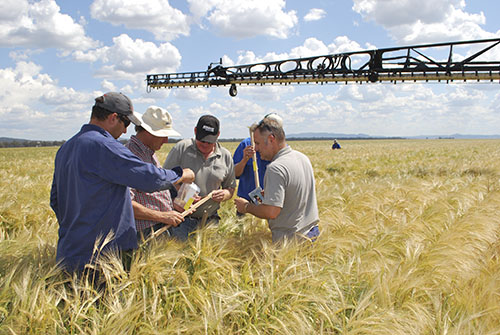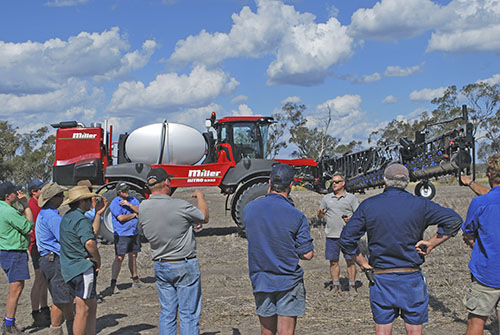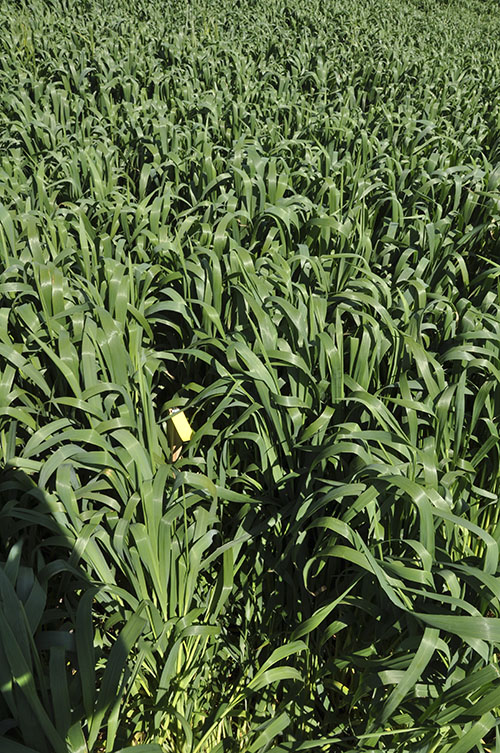

17 December 2015

Jon Bent (right), McIntosh Distribution, and growers and agronomists in the Red Bobs area of the Liverpool Plains in New South Wales pictured collecting spraying samples following a demonstration of the Miller Spray Air system on a Miller Nitro, front-mounted self-propelled sprayer.

Jon Bent, McIntosh Distribution, talks to growers and agronomists about the workings and range of benefits of the Miller Spray Air system.

Pictured shows the water sensitive paper placed at a height of 500mm in a dense oaten hay crop canopy on Chris Hockey’s Gibson property in Western Australia, where the Miller Spray-Air system showed significantly better spray coverage.
NATIONWIDE demonstrations comparing air boom spraying technology with conventional systems has spiked grower interest in the latest technology.
The Miller Spray Air nozzle system became available on the manufacturer’s popular Nitro, front-mounted self-propelled sprayers this spring and has been quickly adopted by various farmers.
In recent months, hundreds of growers and agronomists Australia-wide have viewed the system in action, demonstrated at field days by Miller dealers in conjunction with national distributor, McIntosh Distribution.
Static demonstrations were a very real demonstration of the benefits of the Spray Air system, but naturally led farmers to want to see the machine in the field.
The Miller system allows for more targeted chemical application through air-assist and air-atomisation technology, forming one powerful spray nozzle system.
Farmers have fingertip control of the droplet size and speed of the air delivery for any spraying application.
Jon Bent, of McIntosh Distribution, said the field day demonstrations allowed farmers the opportunity to test how the Miller Spray Air system worked in their conditions.
“Most growers are immediately familiar with the benefits of added air penetration in post-emergent and late canopy applications, but, by using water sensitive paper in a variety of field conditions, they could see all-year-round benefits with the system,’’ Jon said.
He said conventional nozzles were used as the comparison in the demonstrations and growers and agronomists were asked what they wanted to see, rather than being shown a standard demonstration.
The performance of the Miller Spray Air system has resulted in a number of retail sales, as well as an increase in general awareness of the system and its benefits.
“In all instances, the Spray Air has bettered the conventional systems, regardless of the application challenge,” Jon said.
“We showed farmers and agronomists what we considered to be important benefits given the particular application challenge and then we threw it to them to try and stump us – nobody could.”
Depending on the region, the challenge put forward to the Miller Spray Air system varied, but Jon said many people voiced concern about spray drift.
He said regardless of the crops grown, all growers were extremely aware of drift and drift control, which, when coupled with a desire to achieve effective coverage, had led to the continued increase in water carrier volumes.
“Big droplets don’t drift, but there is a lot less of them to physically hit the target, especially when targeting small grass weeds. This is why guys are using so much bigger water rates.”
He said small weeds in shaded stubble rows was another challenge thrown up by farmers in one high yielding area.
“When comparing the actual droplet deposition in the worst-affected, downwind, shaded side of the heavy cereal stubble, the Spray Air more than doubled the number of droplets applied against a conventional air mix nozzle for the same water volume and far less drift,” Jon said.
Late fungicide and insecticide applications also showed a marked application benefit in tall and full canopied crops.
Jon said in these cases, the Miller Spray Air system was achieving more coverage in the top of the canopy, the front and rear standing vertical faces, as well as hitting the base of the canopy, for less than half of the water rate than a conventional system.
“Being a pure application company, Miller and its associated sales professionals have decades of combined spray experience and understand what these challenges are,” he said.
“Conventional nozzles and even pulse-width modulation (PWM) systems make driftable fines when spraying even at low pressures. It’s just the nature of how standard hydraulic nozzles work regardless of the nozzle type.
“The Miller Spray Air system removes the majority of these from the spray pattern, so more of the appropriate-sized droplets hit the target, resulting in better targeted weed/pest control.
“Adding air to force the droplet towards the target reduces any potential drift issues again.
“The Spray Air is a tool that allows farmers to manage targeted application of all chemicals to the best possible result in all situations,” Jon said.